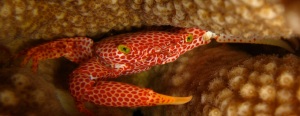
Our Ocean Bridges program (funded by the French-American Cultural Exchange’s Partnership University Fund) has been a very successful collaboration between UF (Craig Osenberg’s and Gustav Paulay’s labs) and CRIOBE/University of Perpignan (Suzie Mills’, Serge Planes’, and Rene Galzin’s labs). In recent years, we worked on a symbiosis between coral and its crustacean inhabitants. Pocillopora is a common and geographically widespread genera of branching coral that houses an extraordinary diversity of crustaceans and fishes. Many of these coral constituents partake in a symbiosis with the coral whereby the coral host provides shelter and food in exchange for protective services by the symbiont (similar to well-known ant-plant mutalisms where ants protect plants from herbivores in exchange for nectar and domatia). Previous work on this symbiosis has emphasized the benefits provided to the coral by crab inhabitants (genusTrapezia) in deterring predators and removing sediment from the coral’s surface. Our research attempted to deepen our understanding of the system in three ways. (1) We seeks to understand and describe new ways in which crustacean mutualists benefit the coral. (2) We study how synergism and antagonism among different symbiont species affect the strength and stability of the mutualism. (3) We address the role of predation as a force affecting the abundance, diversity, and composition of the crustacean guild.
We recently published two papers in Coral Reefs — one describe a new component of this mutualism, whereby coral crustaceans ameliorate the negative effects of mucus-feeding snails (Dendrapoma maximum). The other explores how two different predatory fishes that also live inside the coral (Flame Hawkfish and Coral Crouchers) affect the abundance and diversity of the crustacean guild.Two companion papers were recently published in Oecologia and PLoS One that examine how ecological services (sediment removal and deterrence of predatory seastars) provided by two coral crustaceans (a crab: Trapezia serenei and a shrimp: Alpheus lottini) shift with crustacean density, identity, and diversity.
This work involved a diversity of participants from the Ocean Bridges program (Mike Gil, Sarah Lemer, Matthieu Leray Sea Mckeon, Suzie Mills, Craig Osenberg) and Jeff Shima (Victoria University Wellington)